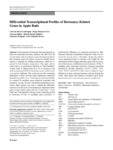Please use this identifier to cite or link to this item:
http://www.alice.cnptia.embrapa.br/alice/handle/doc/993551Full metadata record
| DC Field | Value | Language |
|---|---|---|
| dc.contributor.author | FALAVIGNA, V. da S. | pt_BR |
| dc.contributor.author | PORTO, D. D. | pt_BR |
| dc.contributor.author | BUFFON, V. | pt_BR |
| dc.contributor.author | MARGIS-PINHEIRO, M. | pt_BR |
| dc.contributor.author | PASQUALI, G. | pt_BR |
| dc.contributor.author | REVERS, L. F. | pt_BR |
| dc.date.accessioned | 2016-02-22T12:38:15Z | - |
| dc.date.available | 2016-02-22T12:38:15Z | - |
| dc.date.created | 2014-08-27 | pt_BR |
| dc.date.issued | 2014 | pt_BR |
| dc.identifier.citation | Plant Molecular Biology Reporter, v. 32, p. 796-813, 2014. | pt_BR |
| dc.identifier.uri | http://www.alice.cnptia.embrapa.br/alice/handle/doc/993551 | pt_BR |
| dc.description | The production of temperate fruit crops depends on plant developmental processes, primarily the shift from the juvenile phase to the reproductive phase, dormancy transitions and flowering. Apple tree (Malus ×domestica Borkh.) development is regulated by chilling temperatures, which are required for bud dormancy progression. The apple cultivar Castel Gala is a spontaneous mutation of "Gala Standard". "Castel Gala" is characterized by a 50 % decrease in the chilling requirement (CR) for dormancy release, which results in an earlier budbreak. This work explores the contrasting phenotypes of these cultivars using suppression subtractive hybridization (SSH). From 1,019 unigenes identified by SSH, we selected 28 candidate genes putatively associated with dormancy cycling. Reverse transcription-quantitative polymerase chain reaction was used to validate the differential expression profiles and to transcriptionally characterize these genes in three distinct apple cultivars ("Castel Gala", "Royal Gala" and "Fuji Standard") during a cycle comprising growth to dormancy. Of the 28 candidate genes analyzed, 17 confirmed the differences in expression predicted by SSH. Seasonal transcript accumulation during the winter was observed for several genes, with higher steady-state mRNA levels maintained longer in cultivars with a high CR. The transcription profiles suggest that these genes may be associated with dormancy establishment and maintenance. Of the 17 candidate genes, transcripts coding for dormancy-associated MADS-box (DAM), dehydrins, GAST1, LTI65, NAC, HTA8, HTA12 and RAP2.12-like proteins displayed major differences in gene expression between cultivars through the winter. These genes were therefore considered good candidates for key roles in the dormancy process in apple trees. | pt_BR |
| dc.language.iso | eng | eng |
| dc.rights | openAccess | eng |
| dc.subject | Castel Gala | pt_BR |
| dc.subject | Fuji Standard | pt_BR |
| dc.subject | Royal Gala | pt_BR |
| dc.subject | Apple | pt_BR |
| dc.title | Differential transcriptional profiles of dormancy-related genes in apple buds. | pt_BR |
| dc.type | Artigo de periódico | pt_BR |
| dc.date.updated | 2019-04-02T11:11:11Z | pt_BR |
| dc.subject.thesagro | Maçã | pt_BR |
| dc.subject.thesagro | Temperatura | pt_BR |
| dc.subject.thesagro | Dormencia | pt_BR |
| dc.subject.thesagro | Genetica vegetal | pt_BR |
| dc.description.notes | DOI 10.1007/s11105-013-0690-0 | pt_BR |
| riaa.ainfo.id | 993551 | pt_BR |
| riaa.ainfo.lastupdate | 2019-04-02 -03:00:00 | pt_BR |
| dc.contributor.institution | Vítor da Silveira Falavigna; Diogo Denardi Porto, CNPUV; Vanessa Buffon, CNPUV; Márcia Margis-Pinheiro; Giancarlo Pasquali; LUIS FERNANDO REVERS, CNPUV. | pt_BR |
| Appears in Collections: | Artigo em periódico indexado (CNPUV)  | |
Files in This Item:
| File | Description | Size | Format | |
|---|---|---|---|---|
| Falavigna2014GenesAppleBuds.pdf | 1,74 MB | Adobe PDF |  View/Open |









